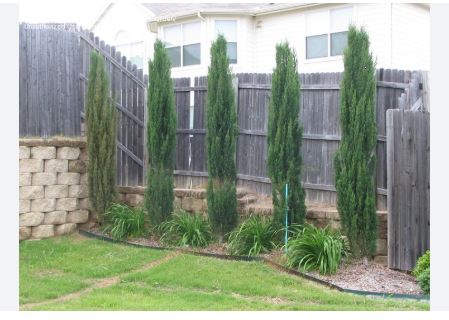
Botanical Classification & Native Area
The Italian Cypress, scientifically named Cupressus sempervirens, belongs to the Cupressaceae family, a diverse group of coniferous trees and shrubs. Within this family, it is classified under the genus Cupressus, which encompasses true cypresses. The species name sempervirens, meaning “ever-living” in Latin, reflects its evergreen nature, retaining vibrant foliage year-round. The tree is further divided into cultivars, with two primary growth forms: the vertical ‘Stricta’ (narrow, pencil-like) and the horizontal ‘Horizontalis’ (broader, spreading branches).
As a gymnosperm, it produces cones rather than flowers, and its taxonomic classification places it alongside other cypresses like the Monterey and Arizona Cypresses. Its close relatives include species in the Hesperocyparis genus, recently reclassified based on genetic studies, though Cupressus sempervirens remains a true cypress.
The Italian Cypress is native to the eastern Mediterranean, with its origins tracing back to regions including southern Greece, Turkey, Cyprus, Syria, Lebanon, and parts of North Africa. Fossil records suggest cypresses existed in the Mediterranean basin millions of years ago, adapting to the region’s warm, dry climate.
The tree has been cultivated since ancient times, with evidence of its use in Persian gardens, Egyptian cemeteries, and Greek mythology, where it was linked to the myth of Cyparissus, a youth transformed into a cypress tree to mourn eternally. While now widely associated with Italy—particularly Tuscany, where it lines roads and estates—its native range spans a broader Mediterranean arc. Centuries of cultivation have naturalized it across southern Europe, blurring the lines between its wild and planted populations.
Identifying Characteristics

The Italian Cypress is instantly recognizable by its tall, narrow, columnar shape, often described as a “pencil” or “candle” form, typically growing 30–80 feet tall and only 3–10 feet wide at maturity. Its foliage consists of scale-like, dark green to gray-green leaves, densely packed in overlapping sprays that give the tree a lush, uniform appearance. The leaves emit a mild, resinous fragrance when crushed.
The tree produces small, round cones, about 1–1.5 inches in diameter, which are woody, brown, and bear 8–14 scales with small, winged seeds. Its bark is thin, grayish-brown, and slightly furrowed, peeling in strips on older trees. Cultivars like ‘Glauca’ feature bluish-green foliage, while ‘Swane’s Golden’ has golden-tipped leaves, adding visual variety. The tree’s upright, symmetrical growth and minimal branching distinguish it from broader conifers.
Habitat
In its native Mediterranean habitat, the Italian Cypress thrives in warm, dry environments, typically found on rocky hillsides, coastal plains, and well-drained slopes at elevations up to 6,500 feet. It prefers full sun, requiring at least six hours of direct sunlight daily, and is highly adaptable to poor, rocky, or sandy soils, provided they are well-drained. The tree is drought-tolerant once established, making it suited to arid and semi-arid climates, but it struggles in waterlogged or heavy clay soils.
In the wild, it often grows in mixed woodlands alongside pines, junipers, and oaks, contributing to Mediterranean ecosystems by stabilizing soil and providing shade. In cultivated settings, it adapts to urban environments, tolerating pollution and wind, though it may need protection from severe frost in colder regions.
Distribution
Originally confined to the eastern Mediterranean, the Italian Cypress has been widely distributed through human cultivation, becoming a hallmark of southern European landscapes, particularly in Italy, Spain, Portugal, and southern France. Its cultivation extends to North Africa (Morocco, Algeria), the Middle East (Israel, Jordan), and parts of western Asia.
Introduced to North America, Australia, and other temperate regions, it is commonly planted in California, the southeastern U.S., and other warm climates. While naturalized in some areas, it is not considered invasive, as it rarely self-seeds aggressively. Its global presence reflects its ornamental popularity and adaptability, with millions of trees lining avenues, estates, and gardens worldwide.
USDA Hardiness Zones
The Italian Cypress thrives in USDA Hardiness Zones 7–10, where average minimum temperatures range from 0°F to 40°F (-18°C to 4°C). It is best suited to mild, temperate climates with hot summers and cool, wet winters, similar to its Mediterranean origins. In Zone 7, it may experience occasional frost damage, particularly on young trees, but mature specimens are generally hardy.
In colder zones (below Zone 7), it requires protection, such as burlap wrapping or planting in sheltered microclimates, as prolonged freezing can damage foliage or roots. In warmer zones (9–10), it flourishes with minimal care, provided irrigation is managed during establishment. Its heat and drought tolerance make it ideal for xeriscaping in dry regions.
Uses
The Italian Cypress is a versatile tree with a wide range of uses, primarily ornamental but also practical and cultural. In landscaping, its tall, narrow form makes it a premier choice for privacy screens, windbreaks, and formal hedges, creating dramatic vertical accents in gardens, along driveways, or in urban settings.
It is often planted in rows to frame vistas or define property boundaries, as seen in iconic Tuscan landscapes. The tree’s compact footprint suits small spaces, and dwarf cultivars like ‘Tiny Tower’ are ideal for containers or patios. Its dense foliage provides year-round greenery, enhancing Mediterranean, classical, or modern garden designs.
Beyond aesthetics, its aromatic, durable wood is used for furniture, carvings, and small crafts, though commercial logging is limited due to its slow growth. Historically, cypress wood was prized for shipbuilding and religious artifacts. Ecologically, it stabilizes soil on slopes and supports wildlife, offering nesting sites for birds.
Culturally, the Italian Cypress is planted in cemeteries across Europe and the Middle East, symbolizing mourning and immortality, and it features in art, literature, and religious traditions. Its essential oil, extracted from leaves and cones, is used in aromatherapy and perfumes, adding to its economic value.
Cultivation of Italian Cypress (Cupressus sempervirens)
Climate Suitability
Italian Cypress thrives in USDA Hardiness Zones 7–10, where minimum temperatures range from 0°F to 40°F (-18°C to 4°C). It prefers Mediterranean-like climates with hot, dry summers and mild, wet winters, but it can tolerate occasional frost. In colder zones, provide winter protection to prevent foliage or root damage.
Site Selection
Choose a location with full sun exposure, receiving at least 6–8 hours of direct sunlight daily, to promote vigorous growth and dense foliage. Avoid shaded areas, as insufficient light can lead to sparse growth and reduced vigor. Ensure the site is sheltered from strong, drying winds, especially for young trees.
Soil Requirements
Plant in well-drained soil with a pH range of 5.5–7.5 (slightly acidic to neutral). Italian Cypress adapts to sandy, loamy, or rocky soils but is intolerant of heavy clay or waterlogged conditions, which can cause root rot. Test soil drainage before planting and amend with sand or gravel if needed.
Planting Time
The optimal planting seasons are early spring or fall, allowing roots to establish before extreme heat or cold. Dig a hole twice as wide and as deep as the root ball, positioning the root collar at ground level. Backfill with native soil, tamping gently, and water thoroughly to settle the roots.
Watering Needs
Water young trees deeply once or twice weekly for the first 1–2 years to establish a strong root system, keeping soil moist but not soggy. Once mature, Italian Cypresses are highly drought-tolerant and require watering only during prolonged dry spells. Overwatering can lead to fungal issues, so ensure proper drainage.
Mulching
Apply a 2–3 inch layer of organic mulch, such as wood chips or bark, around the base of the tree, extending out to the drip line but keeping it 2 inches from the trunk. Mulch conserves soil moisture, regulates temperature, and suppresses weeds, benefiting young trees in particular.
Fertilization
Fertilize sparingly, as Italian Cypresses are not heavy feeders. In spring, apply a balanced, slow-release fertilizer (e.g., 10-10-10) to young trees to encourage growth. Avoid over-fertilizing, which can cause weak, leggy growth or needle burn. Mature trees rarely need supplemental feeding in fertile soils.
Pruning
Minimal pruning is required due to the tree’s naturally tidy, columnar shape. In late winter or early spring, remove dead, damaged, or crossing branches using clean, sharp shears. Lightly trim to maintain desired height or shape, but avoid cutting into old wood, as it does not readily regenerate. Regular pruning is unnecessary for most specimens.
Pest and Disease Management
Monitor for pests like spider mites, aphids, or cypress bark moths, which can be treated with insecticidal soap or neem oil. Watch for fungal diseases such as cypress canker (Seiridium cardinale), which causes branch dieback; improve air circulation and avoid overhead watering to prevent it. Ensure proper spacing to reduce disease risk.
Spacing
Space trees 3–6 feet apart for hedges or privacy screens, or 10–15 feet apart for individual specimens, accounting for their mature width of 3–10 feet. Proper spacing ensures adequate sunlight and air circulation, reducing competition and disease susceptibility. Consider their mature height (30–80 feet) when planning near structures.
Wind Protection
Young Italian Cypresses are susceptible to wind damage due to their shallow roots and narrow form. Stake newly planted trees for the first 1–2 years in windy areas, using flexible ties to allow slight movement, which strengthens the trunk. Remove stakes once the root system is established to prevent dependency.
Winter Care
In Zone 7 or colder areas, protect young trees from winter burn or frost damage by wrapping them in burlap or applying an anti-desiccant spray to foliage. Ensure soil is adequately moist before winter to prevent dehydration, as evergreens lose moisture through needles in cold, dry conditions.
Long-Term Growth
Italian Cypresses grow moderately fast, adding 1–2 feet per year under optimal conditions, reaching 30–80 feet at maturity, depending on the cultivar (e.g., ‘Stricta’ or ‘Glauca’). Plan for their tall, narrow profile, as they are ideal for formal gardens, avenues, or as vertical accents but unsuitable for small spaces. Regular monitoring ensures they remain healthy and structurally sound.